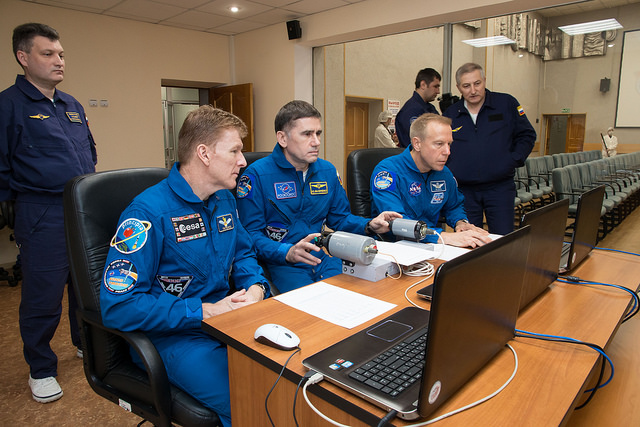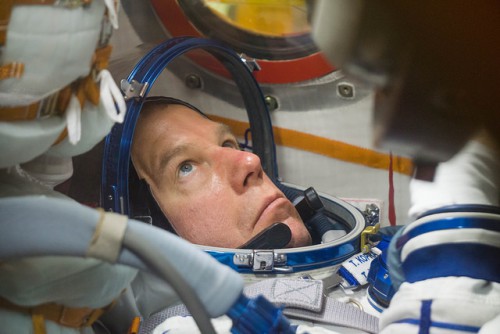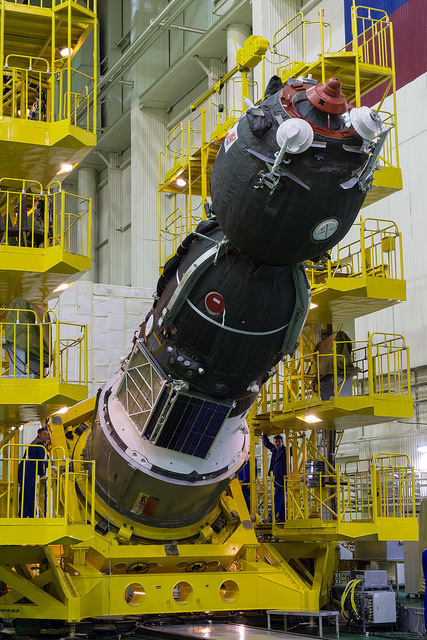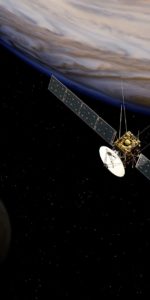
Three new residents are entering their final 24 hours on Earth, ahead of launching tomorrow (Tuesday, 15 December) from Baikonur Cosmodrome in Kazakhstan aboard the Soyuz TMA-19M spacecraft. Veteran cosmonaut Yuri Malenchenko—who becomes only the second Russian after Sergei Krikalev to chalk up as many as six spaceflights—will command the flight to the International Space Station (ISS), flanked by U.S. astronaut Tim Kopra and Britain’s Tim Peake. Launching at 5:03 p.m. local time (6:03 a.m. EST), the three spacefarers will pursue a now-standard “fast rendezvous” profile, lasting six hours and four orbits of the Home Planet, before docking at the Earth-facing (or “nadir”) Rassvet module of the Russian Orbital Segment (ROS) at 12:24 p.m. EST.
Upon arrival at the space station, Malenchenko, Kopra, and Peake will form the second half of the incumbent Expedition 46 crew, which comprises Commander Scott Kelly of NASA and Russian cosmonauts Mikhail Kornienko and Sergei Volkov. Present plans call for the new crew to remain in orbit until early June 2016, with Kopra rotating into the command of Expedition 47 in March.
As outlined in a recent AmericaSpace article—featuring imagery by our Johnson Space Center (JSC) correspondent Michael Galindo—the mission promises to shift Malenchenko up the experience table to become one of the world’s top three most seasoned spacefarers, as well as offering a long-overdue return to orbit for Kopra (who was grounded from the STS-133 shuttle flight just a few weeks before its February 2011 launch) and marking out Peake as the first “official” British astronaut, sponsored by the UK Government. Peake, who was assigned to the mission amid great fanfare in May 2013, is flying his “Principia” expedition under the auspices of the European Space Agency (ESA). He was joined later that year by Kopra, with Malenchenko assigned much later, replacing Sergei Zalyotin, who retired from the cosmonaut corps in early 2014.
Having wrapped up their final mission preparations and two days of final qualification exams, Malenchenko, Kopra, and Peake and their backups—Russian cosmonaut Anatoli Ivanishin, NASA astronaut Kate Rubins, and Japan’s Takuya Onishi, who are currently expected to serve as prime crew for the first flight of the new Soyuz-MS spacecraft in June 2016—flew from the Star City training center, on the forested outskirts of Moscow, and into desolate Baikonur on 30 November. Next day, Peake tweeted excitedly that he had seen and gotten acquainted with Soyuz TMA-19M in Baikonur’s Site 254, that “everything checked out perfectly” and later added that he had practiced donning and doffing and leak-checking the “shady character” of his Sokol (“Falcon”) launch and entry suit.

Meanwhile, Soyuz TMA-19M was transferred to the Spacecraft Assembly and Testing Facility, where it was loaded with 1,760 pounds (800 kg) of unsymmetrical dimethyl hydrazine and nitrogen tetroxide for its attitude-control propellants, as well as helium pressurant and oxygen and nitrogen for its environmental control systems. After the installation of the aerodynamic payload shroud on 8 December, Soyuz TMA-19M was installed atop the Soyuz-FG booster and yesterday (Sunday) the entire stack was rolled in a horizontal configuration from the Assembly and Testing Facility to Site 1/5, the famed “Gagarin’s Start, from where humanity’s first spacefarer began his epochal voyage, way back in April 1961. A State Commission meeting evaluated all final issues and delivered a definitive “Go” to proceed with Tuesday’s launch attempt. “Getting real,” tweeted Tim Kopra on Sunday, as he shared two glorious images of the booster during rollout and standing tall on the pad. “Our rocket is on the launchpad. Our crew is ready!”
Launch Day promises to be a long one for the prime and backup crews, who will be awakened about 8.5 hours before T-0. They will shower and be disinfected, after which microbial samples will be taken in support of scientific and biomedical investigations. Breakfast will be followed by departure from Baikonur’s Cosmonaut Hotel and the traditional blessing by a Russian Orthodox priest. Malenchenko, Kopra, and Peake will then be bussed to Site 254, where they will undergo final medical checks and don their Sokol suits. This will also be the final opportunity for them to speak, face-to-face, with their families, albeit from behind glass screens. They will then depart Site 254 for the launch pad.
At Site 1/5, they will be ensconced into their specially contoured seats aboard the Soyuz TMA-19M descent module about two hours prior to liftoff. Malenchenko will occupy the center couch, commanding the flight, with Kopra to his left side as “Flight Engineer-1” and Peake to his right as “Flight Engineer-2.” Their Soyuz-FG booster—a direct descendent of Chief Designer Sergei Korolev’s R-7 booster, the world’s first Intercontinental Ballistic Missile (ICBM)—will undergo final checks and be fully fueled with a highly refined form of rocket-grade kerosene, known as “RP-1,” together with liquid oxygen. The latter will enter a “topping” mode after loading, and all cryogenic boil-off will be continuously replenished until shortly before T-0, thus ensuring that all tanks remain at “Flight Ready” levels, prior to the ignition of the RD-108 first-stage engine and the RD-107 engines of the four tapering, strap-on boosters.
It has become traditional for Soyuz crews to listen to their own choice of music, piped into the spacecraft’s cabin, in the final minutes before liftoff. Last week, Peake tweeted that “I get to pick 3 songs to listen to in the Soyuz just before launch” and rhetorically asked “What would you choose whilst sat on top of 300 tons of rocket fuel?” After receiving many suggestions from among his 61,600 followers, he reached his final decision: in addition to the musical choices of Malenchenko and Kopra, the first official British astronaut will savor the strains of Queen’s “Don’t Stop Me Now,” U2’s “Beautiful Day,” and Coldplay’s “A Sky Full of Stars” during his final minutes on terra firma. “Gonna need to be real loud,” Peake added, somewhat understatedly.

In the last 15 minutes of the countdown, the Launch Abort System (LAS) will be armed and transferred to Automatic Mode and the crew will be instructed to close their visors. At this stage, Malenchenko’s controls will be activated. Internal avionics will be initiated and the on-board flight recorders will be spooled-up to monitor the systems of the booster during its ascent to orbit. Inside the control bunker, the “launch key”—an actual, physical key—will be inserted in order to enable the rocket’s ordnance. This will be followed by gaseous nitrogen purging, pressurization of the propellant tanks, and final cryogenic topping. At T-60 seconds the Soyuz-FG will transition to Internal Power, and at T-10 seconds the engine turbopumps will attain full speed. Five seconds later, the engines of the core and tapering boosters will roar to life and quickly reach maximum power. This will produce a retraction of Site 1/5’s fueling tower and a liftoff into the steadily darkening Baikonur sky at 5:03 p.m. local time (6:03 a.m. EST).
Rising rapidly, the vehicle will exceed 1,100 mph (1,770 km/h) within a minute of liftoff, and at T+118 seconds the four tapering boosters will be jettisoned, leaving the core alone to continue the boost into low-Earth orbit. By the two-minute mark, Malenchenko, Kopra, and Peake will surpass 3,350 mph (5,390 km/h), and, shortly afterwards, the escape tower and launch shroud will separate, exposing Soyuz TMA-19M to the near-vacuum of the rarefied high atmosphere for the first time. Five minutes after departing the desolate steppe of Central Asia in a blaze of fire and light, the core booster will separate at an altitude of 105.6 statute miles (170 km) and the third and final stage will ignite, accelerating the ISS-bound trio to a velocity of more than 13,420 mph (21,600 km/h). By the time of third-stage separation, at nine minutes into the flight, the crew will enter an orbit of about 125 x 160 miles (200 x 260 km), inclined 51.6 degrees to the equator.
Another tradition is the presence of a “zero-gravity indicator” in the cabin to alert the crew about the onset of weightlessness. Previous astronauts and cosmonauts have carried toys from their children, including a giraffe by Soyuz TMA-13M’s Reid Wiseman and the “Frozen” character Olaf by Soyuz TMA-15M’s Anton Shkaplerov. For Tuesday’s launch, the crew will carry a gold medallion, bearing the image of Yuri Gagarin, which Malenchenko recently explained was being carried in honor of 2016’s 55th anniversary of the historic Vostok 1 voyage. “The flight of the first Earthling opened the era of manned spaceflight,” explained Malenchenko recently, “and I am very proud that, together with my colleagues, I have the most direct bearing on the continuation and development of the Space Age.”
After entering orbit, the process of deploying Soyuz TMA-19M’s solar arrays and communications and navigational appendages, preparatory to a series of four maneuvering “burns” to raise the apogee of their orbit to reach the operational altitude of the ISS. The first burn (designated “DV-1”) should occur 45 minutes into the mission, after which a second burn (DV-2) is timed at 90 minutes after liftoff. These will be followed by another pair of burns, later in the rendezvous sequence, which should position the spacecraft for an on-time docking at the station’s Earth-facing (or “nadir”) Rassvet module at 12:24 p.m. EST, about six hours and 21 minutes into the flight. This will be followed by standard pressure and leak checks and hatches are expected to be opened into the station by 2 p.m. EST, when the new arrivals will be welcomed aboard their new orbital home by the incumbent Expedition 46 crew of Scott Kelly, Mikhail Kornienko, and Sergei Volkov.
Want to keep up-to-date with all things space? Be sure to “Like” AmericaSpace on Facebook and follow us on Twitter: @AmericaSpace
Missions » ISS » Missions » ISS » Soyuz TMA-M »



